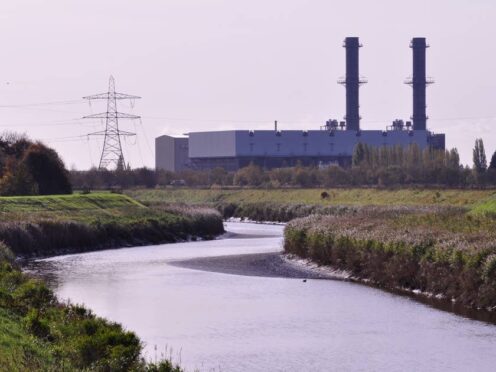
The Government will “stand with” electricity generators as they invest in building more gas-fired power stations, Energy Secretary Claire Coutinho has said.
In a speech at Chatham House, Ms Coutinho said there was an ongoing need for fossil fuel gas in the electricity mix, warning that “without gas backing up renewables, we face the genuine prospect of blackouts”.
Reaction to the statement was mixed, with experts acknowledging the need for some unabated gas in the coming years, but warning that building new gas plants should not delay efforts to move electricity generation away from fossil fuels.
The Government has a target to decarbonise the power grid by 2035 as part of efforts to cut emissions by nearly four-fifths, on the way to cutting climate pollution to zero overall – known as net zero – by 2050.
And green groups reacted angrily, calling for clear policies to end unabated gas by 2035 at the latest.
Ms Coutinho said this includes rolling out renewables such as offshore wind, and backing them up with clean technology to capture emissions on gas power plants or scaling up new technologies such as hydrogen gas-fired power when they are ready.
But she said: “We will need some tried-and-tested capacity until these kick in”.
“For this brief window of time, that leaves us with unabated gas.”

With around 15 gigawatts (GW) of power generation due to come off the system in the coming years, a minimum of 5GW of new power sources would be needed to ensure security of supplies, she said, which would include new unabated gas power stations.
“So, I say this to all our electricity generators here in the UK: renewables will play an ever-more critical role in powering Britain, but I will not risk our energy security by refusing to address the difficult short-term choices we need to make.
“The Government will stand with you as you invest in building more gas power stations.
“And if investors are serious about reaching net zero without damaging the economy or hiking bills for families, then they should stand with you too.”
How can reforming our electricity markets
💷save up to £35 billion over 20 years?🔌help decarbonise the grid by 2035?💡keep the lights on as we transition to more renewables?
Swipe to find out and click on any of the graphics to read more.
— Department for Energy Security and Net Zero (@energygovuk) March 12, 2024
She said all new gas-powered stations needed to be “net zero ready”, so they could connect to carbon capture technology or be changed to burn hydrogen instead of gas, and they would be run less frequently as more low-carbon generation and long-term storage was built.
Dr Callum MacIver, research fellow, University of Strathclyde, said the Government was right to emphasise the need to keep the lights on.
“It is widely acknowledged that, at least in the short to medium-term, retaining a reasonable capacity of unabated gas plant on the system is a sensible risk management measure.”
But he warned: “We must guard against ‘baking in’ a delay to our decarbonisation process.”
He said it was essential not to waste money by building too much new unabated gas, and that there was a clear pathway to using low-carbon hydrogen and carbon capture and storage technology.
But Dr Iain Soutar, senior lecturer, University of Exeter, said: “Investing in new gas power stations is a backwards step, away from a more secure and low-carbon energy system.
“Continuing to rely on gas for electricity will mean prolonging our exposure to a volatile international market – and therefore high energy costs for consumers.”
Rick Parfett, WWF’s senior climate policy advisor said “using homegrown clean hydrogen and batteries is the way to keep the lights on, not importing expensive, polluting gas”.
“The Government must legislate to ensure that any new plants can easily convert to hydrogen and only run for a very limited number of hours until this has happened.
“To meet the UK’s net zero target we need a clear plan for phasing out unabated gas.”
Greenpeace UK’s head of politics Rebecca Newsom, said: “This is not the way to deliver billions of pounds of private investment in a clean-energy system fit for the future.
“Instead the Government must prioritise advancing technologies which can store renewable energy throughout the year, and set out clear policies to seek an end to unabated gas by 2035 at the latest.”

Enjoy the convenience of having The Sunday Post delivered as a digital ePaper straight to your smartphone, tablet or computer.
Subscribe for only £5.49 a month and enjoy all the benefits of the printed paper as a digital replica.
Subscribe